Float Bridges
Perhaps the most distinctive ruins at the 60th Street Railyard are the remains of three float bridges that were used to transfer cars from car float barges to the railyard tracks. The northernmost bridge is capped by a gantry frame.
Three gentlemen who had some professional association with the rail yard responded to a posting on railroad.net regarding the history of these structures:
Jim Ferrante
Hired out in 72nd on the Float Bridges in 1953 - first of a few jobs 'tween there and 33rd with side trip "trucking" LCL freight at Yonkers, then went to 466. On the outbound side we made floats for Wken, B&O, PRR, BEDT,CNJ,SIRT,LIRR and BUSH. The LI floats always seemed to carried a lot of construction materials. I pinned floats from Wken,the PRR,B&O( nicest looking tugs-Blue/Gray/Yellow Stipes.)SIRT. Also remember Gons & flats of Auto frames for Chevy TTown. Don't remember any NHRR tugs or floats.
Best move and don't know the official reason for this was a fall day- loaded a 3 tracker with head end cars of bag mail from Morgan Annex dest Penn Station NY. Could never figure why they brought 'em up frm 3Oth Street NY, floated 'em cross the Hudson to Wken then to NJct for the PRR to take back into Penn Station. Must have been a hot move 'cause the GYM(C Holmes) & the YM were on hand to supervise to load. Thought it was a dumb move but as junior man was told "Hey kid,all your thoughts were dumb."
All 3 bridges were different. 4 was the newest (1914?) and easiest to work. 3 was open to the weather and a bear to work in the winter. With loaded floats you had to play with which way the river was flowing and which way the wind was blowing. Made a big difference when you started pulling on the winch wheels to tighten up the 4" hawser that secured to float into the apron. The 4 pins then controlled laterial movement. The tug capt.could slip it right to the apron or bounch it off the rack and make you sweat to get it in to pin it. Bridge 3 also had its own spl reach car a high side gon loaded with debris that was used when ever tide was up and the pontoon section had to be pushed down to line up the apron w/the float.
There was a Bridge 1 at 60th St.Just south of Dock B. My father worked it. Believe it was closed right after WW2?? Same style as Bridge 2. There was a team track milk yard at 6oth at the SE end of the yard,along the ave. Lead was on the left side of the cut as it started down. The land was sold to the NY Times for their "new" bldg. As a kid went to see the "Train of Tomorrow" there.
The floats were worked by one 5 man yard crew,and at the bridges were a Bridge Foreman,a clerk (doubled as weigh master) and 2 bridge operators. Inbound bills were walked to the yard office at 72nd and outbound bills were taken back to the bridge office. Two track platform floats(without Roofs) were also used for lighterage along side ships tied up at the piers. While I was there a few DES3 were working but Alco switchers were prime yard power, fgt diesel handled the frts while R's took the Mail & Express.
Ed Weinstein
In the early 1930s, when my family was living on West 73 and 74 Streets, I used to walk down in the park to a sort of esplanade behing the old roundhouse and under the "Miller" highway. One could get a good view of what went on from ground level. Another viewpoint was from a bridge for employees from the end of either 70th or 71 Street.
The roundhouse, which I think in steam days ( no, although I did see steam further up on the West Side Freight Line, about 1930 when I was four years old, I never saw the roundhouse when it was steam operated) had about sixteen tracks had been reduced to maybe seven or eight. Next to the roundhouse was the YMCA, and also the yard office.
Most of the piers were used for lighterage. One of the oddities of the float bridges was that each one of the three was a different design, at least according to an article in "Transfer" some time ago. The NYC had a direct interchange with the the New Jersey railroads via the River Division ("West Shore") and the New Jersey Junction, so the main interchange function of the float bridges was for the LIRR. As late as the 1960s, symbol freight schedules showed two with LIRR connections. Another interesting function of the float bridges was "open Lighterage", a separate classification at Selkirk. This was putting loads on flats or gondolas, then putting the cars onto a car float to be moved by a tug along side a ship for loading. In a wonderful book "New York Shipping" by Willam H. Miller, there is a photograph of NYC float E27, with eight flat cars, each one of which had/has a street car (double truck Birney, to my uneducated eye) for shipping to Brazil via the Moore McCormack Line. They are being hoisted aboard the steamer by the floating crane "Columbia", and the site is the steamship company's pier at Canal Street.
The power in those days was all R2 motors and the DEs tripower switchers. In the 1930s, although I never thought about it, one of the big commodities unloaded at 60th Street was passenger automobiles; in those days, Broadway between Columbus Circle and 72nd Street was lined with automobile dealers. There was a lot of milk traffic at 60th Street; where the CBS studios are at 57th Street was the site of Sheffield Farms' dairy, which had direct rail access. But, I also think that there was other milk traffic handled through a team track setup west of 60th Street. The basic milk train service was two trains, one from the Albany/Troy area with many cars from D&H points, the other from Utica with Adirondack area cars. Also, there was the "Rutland Milk Train", which came down from Chatham ia the Harlem/Electric.
One other car float function was "dimensional" loads from Weehawken for West Side Freight Lion points; the restricted clearances on the Hudson Division made this neccessary. One other interchange of a direct nature was between the NYC and the NHRR was via Port Morris. This local area freight, to and from Bronx, Westchester and lower Fairfield County NHRR points.
Gordon Davids
When I worked at Yonkers Yard in 1961-61, we handled a good bit of traffic for Habershaw Cable & Wire (Phelps-Dodge) at Yonkers, and Anaconda at Hastings. Most of the loads in and out from the PRR and other NJ railroads moved over the 60th Street Float Bridges. Every night after supper KD-11, the first trick Yonkers traveling switcher, went to 72nd Street with as many as 50 or 60 cars, and returned with about the same. Most of those originated or terminated between Tarrytown and Spuyten Duyvil, and were interchanged at 60th Street.
I think I remember FGEX reefers coming over 60th Street for Bronx Terminal Market with Florida produce. BTM had a float bridge, too, but the only cars I ever saw come across it were wine cars from the Erie. Their tug would come from Jersey City about once a week with one wine car on a float. They operated the bridge and landed the car themselves with a cable and capstan, so all I had to do was get the waybill and make an interchange report.
I was working second trick at Yonkers Yard in 1960 when Dock I burned. We could see the smoke up there. I think it had been used for transferring automobiles to lighters.
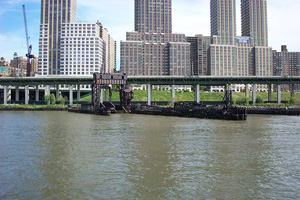
Northern gantry bridge
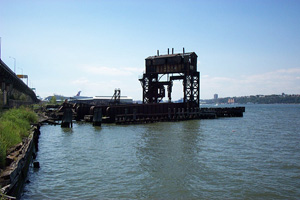
Northern gantry bridge
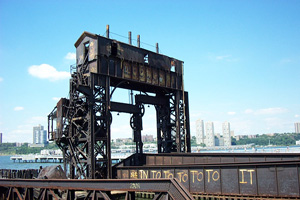
Northern gantry bridge
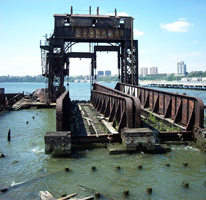
Northern gantry bridge
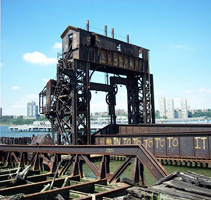
Northern gantry bridge
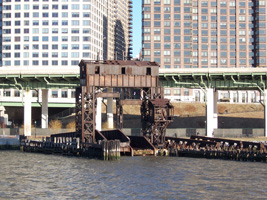
Northern gantry bridge

Observation platform on northern gantry bridge
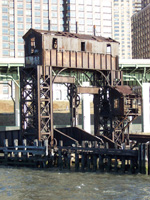
Northern gantry bridge
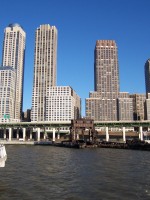
Northern gantry in the shadow of Riverside South
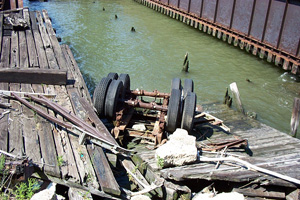
Old truck wheels on float bridge remains
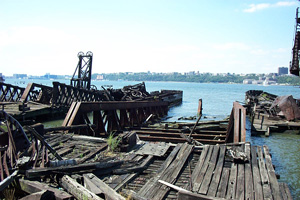
Center float bridge
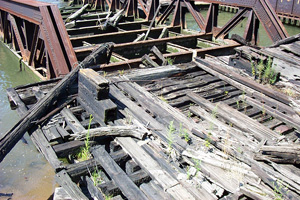
Old rails to center float bridge
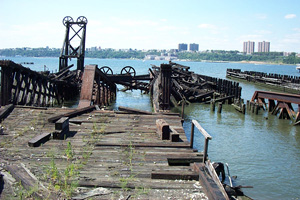
Southern float bridge

Southern float bridge
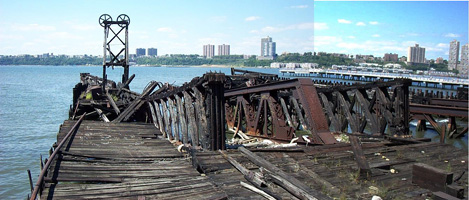
Southern float bridge

Dock guides
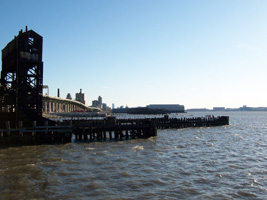
Dock guides

Float bridges
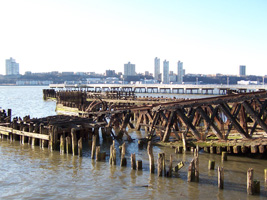
Float bridges

Float bridge gantry
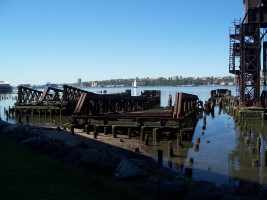
Southern float bridges
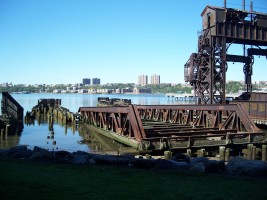
Central float bridge
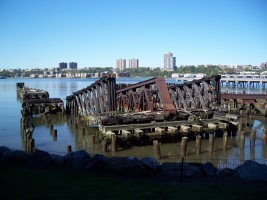
Southern float bridge
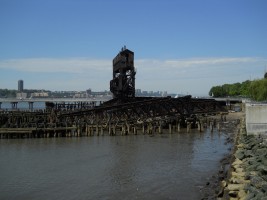
Float bridges
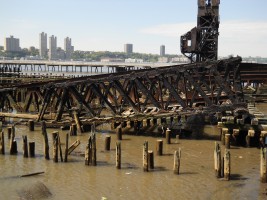
Southern float bridge
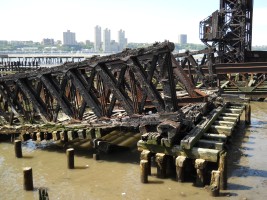
Southern float bridge
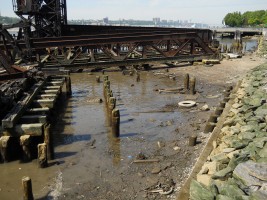
Float bridge shoreline
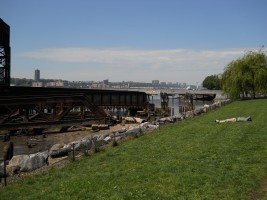
Float bridge shoreline
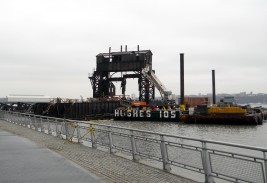
Renovation
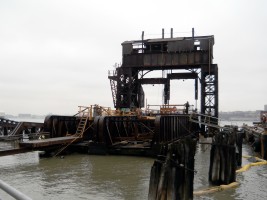
Renovation
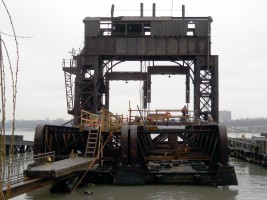
Renovation
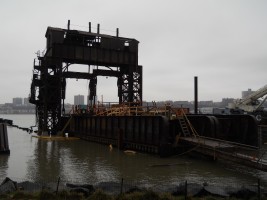
Renovation
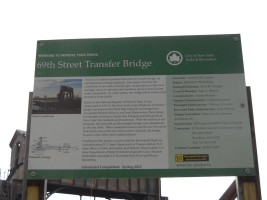
Renovation